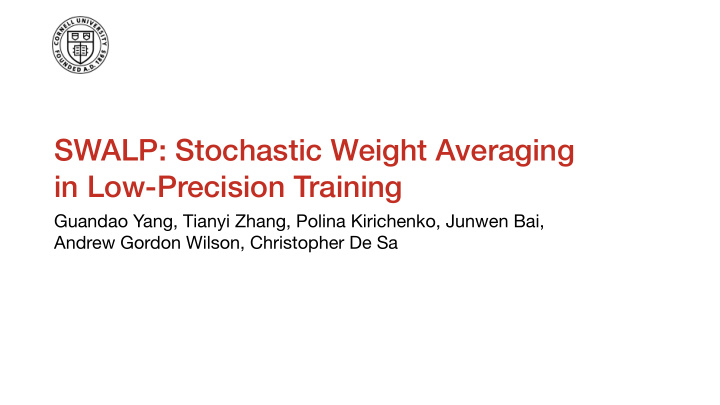



SWALP: Stochastic Weight Averaging in Low-Precision Training Guandao Yang, Tianyi Zhang, Polina Kirichenko, Junwen Bai, Andrew Gordon Wilson, Christopher De Sa
Low-precision Computation
Problem Statement We study how to leverage low-precision training to obtain a high-accuracy model.
Problem Statement We study how to leverage low-precision training to obtain a high-accuracy model. Output model can be higher-precision.
SWALP SWALP SGD-LP model model
SWALP SWALP SGD-LP model model Updating
SWALP SWALP SGD-LP Every c model model iterations Averaging Updating
SWALP Infrequently SWALP SGD-LP Every c model model iterations Averaging Updating
Convergence Analysis Let T be the number of iterations. Theorem 1 (quadratic) SWALP converges to the optimal solution at a O(1/T) rate.
Convergence Analysis Let T be the number of iterations. Theorem 1 (quadratic) SWALP converges to the optimal solution at a O(1/T) rate. SWALP has the same convergence rate as full precision SGD.
Convergence Analysis Let δ be the quantization gap. Theorem 2 (strongly convex) The expected distance between SWALP solution and the optimal one is bounded by O( δ ^2).
Convergence Analysis Let δ be the quantization gap. Theorem 2 (strongly convex) The expected distance between SWALP solution and the optimal one is bounded by O( δ ^2). • The best bound for SGD-LP is O( δ ) (Li et al, NeurIPS 2017). • SWALP requires half the number of bits to reduce the noise ball by the same factor.
Experiments
Experiments 1.3 2.9 0.8 2.3
Experiments
Poster @ Pacific Ballroom #58 SWALP Codes QPyTorch: A Low-Precision Framework
Recommend
More recommend